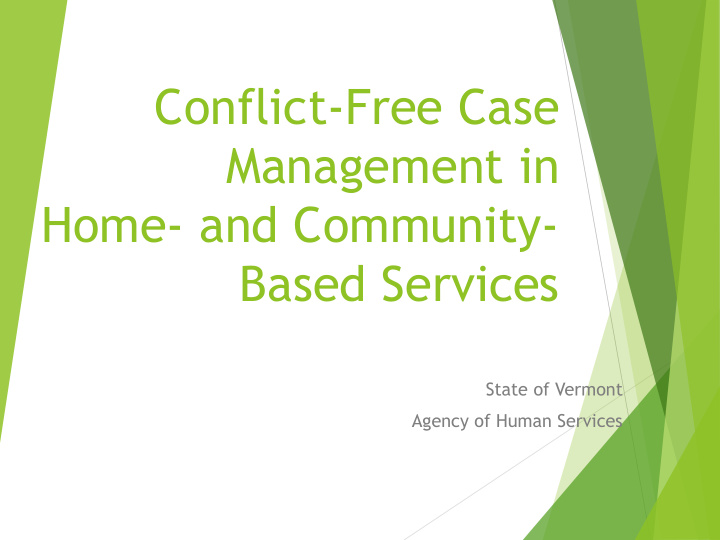



Conflict-Free Case Management in Home- and Community- Based Services State of Vermont Agency of Human Services
Summarizes the concept of conflict-free case management, Details CMS expectations regarding conflict-free case management, This presentation… Describes HCBS programs offered by Vermont Medicaid, and Outlines the next steps the State is taking to ensure compliance.
Home- and Community-Based Services Rule January 16, 2014: the Centers for Medicare and Medicaid Services (CMS) issued final regulations on home- and community-based services (HCBS) requirements (79 FR 2947). Supports enhanced quality in HCBS programs Outlines person-centered planning practices Promotes participation in community Ensures people receive services in the most integrated setting of their choice Includes a requirement that case management be provided without undue conflict of interest.
What is conflict-free case management? Definition: a real or seeming incompatibility between the private interests and the official responsibilities of a person in trust. In other words: a conflict of interest is when a person has competing influences that could affect a decision or action. Federal rule requires that HCBS programs use a person-centered planning process. Includes ways to solve conflict or disagreement. HCBS providers may not provide case management to or develop the person-centered service plan for people receiving services.** **CMS allows for an exception to the rule above when the State demonstrates that there is not other willing and qualified entity.
Other Applicable Regulations 42 CFR § 431.10 State Medicaid Agency Requires that the State Medicaid Agency be responsible for eligibility determinations and eligibility determination can only be delegated to another governmental agency. This refers to Medicaid eligibility determinations; not service authorization 42 CFR 441.730(b) Conflict of Interest Standards Gives more detail on what CMS sees as a potential conflict of interest: Family relationships Financial responsibility Ability to make health- or financially-related decisions for a person
Examples of Conflict of Interest Self-referral: 1. An organization provides both case management and direct services. There are two other organizations that could serve people. The case manager has a potential incentive to refer people to services within his/her own organization as opposed to an outside agency that could be a better fit in terms of services provided or location. Quality Oversight: 2. In the same situation as above, due to the case manager needing to assess the performance of coworkers, there is also potential for conflict of interest for the case manager in ensuring that supports and services are being provided in a high-quality manner in accordance with the service plan. Steering: 3. A case manager may, due to their conscious or unconscious opinion on the best interest of a beneficiary, steer towards or away from certain providers or services, which could artificially limit the available pool of providers or set of available services.
General Solutions Robust laws and regulations in support of individual choice and the person-centered 1. planning process. Uniform assessment and referral tools and procedures to ensure equal treatment across 2. providers. Ongoing quality oversight and monitoring by state staff, including the use of corrective 3. action plans as needed. Separation of case management providers from direct service providers through internal 4. organization structure (firewalls, supervision structure, secondary reviewers, etc.) or by requiring separate organizations to perform the tasks. Payment reform and service delivery approaches that promote person-centered planning 5. and quality outcomes as opposed to a fee-for-service concept where providers are reimbursed for each service provided. Payment reform and service delivery approaches which do not incentivize providers to 6. seek out or avoid certain people due to their needs. Creation or recruitment of new case management or direct service providers. 7. Note: This is not a comprehensive list of ways to resolve potential conflicts
The Agency of Human Services (AHS) has been progressive in pursuing a home- and community- based continuum of care that offers: Meaningful community integration, Strives to promote health, wellness, Vermont choice, and self-direction. and improved quality of life. HCBS Programs The following HCBS programs are authorized through the 1115 Global Commitment to Health waiver: Developmental Traumatic Community Enhanced Disabilities Choices for Brain Injury Rehabilitation Family Services Care Program and Treatment Treatment Program
History and Next Steps Goal: ensure compliance with federal regulations described previously (compliance may have different meanings depending on the program). 2016: AHS asked CMS for guidance on how to best ensure compliance with person-centered planning requirements. Using information from the assessment, AHS is doing a 2-phase stakeholder engagement process: Phase I: Provide stakeholders with info on federal requirements and current status of 1. HCBS programs. AHS is not proposing and changes during this phase. Collect feedback from stakeholders, including possible changes, if any. 2. Phase II: Based on the assessment and stakeholder feedback, provide stakeholders with 1. potential changes, if any, to resolve or mitigate any identified conflicts. Collect feedback from stakeholders. 2. Conduct public notice and collect formal comments. 3.
Recommend
More recommend